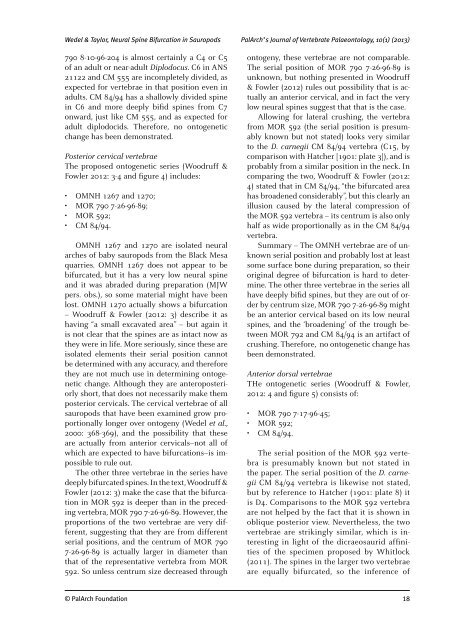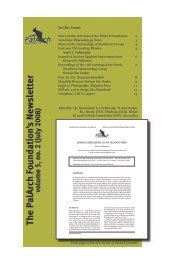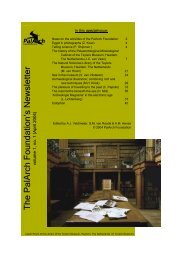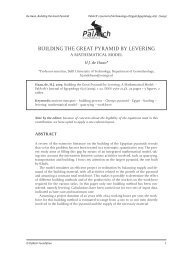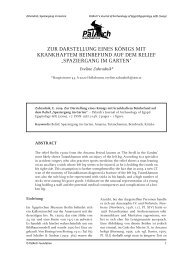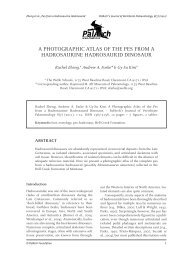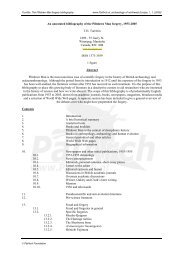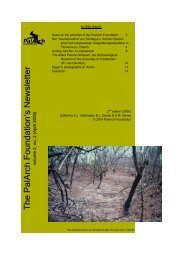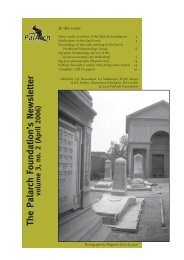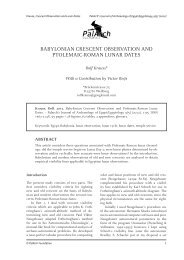neural spine bifurcation in sauropod dinosaurs of the - PalArch
neural spine bifurcation in sauropod dinosaurs of the - PalArch
neural spine bifurcation in sauropod dinosaurs of the - PalArch
Create successful ePaper yourself
Turn your PDF publications into a flip-book with our unique Google optimized e-Paper software.
Wedel & Taylor, Neural Sp<strong>in</strong>e Bifurcation <strong>in</strong> Sauropods <strong>PalArch</strong>’s Journal <strong>of</strong> Vertebrate Palaeontology, 10(1) (2013)<br />
790 8-10-96-204 is almost certa<strong>in</strong>ly a C4 or C5<br />
<strong>of</strong> an adult or near-adult Diplodocus. C6 <strong>in</strong> ANS<br />
21122 and CM 555 are <strong>in</strong>completely divided, as<br />
expected for vertebrae <strong>in</strong> that position even <strong>in</strong><br />
adults. CM 84/94 has a shallowly divided <strong>sp<strong>in</strong>e</strong><br />
<strong>in</strong> C6 and more deeply bifid <strong>sp<strong>in</strong>e</strong>s from C7<br />
onward, just like CM 555, and as expected for<br />
adult diplodocids. Therefore, no ontogenetic<br />
change has been demonstrated.<br />
Posterior cervical vertebrae<br />
The proposed ontogenetic series (Woodruff &<br />
Fowler 2012: 3-4 and figure 4) <strong>in</strong>cludes:<br />
• OMNH 1267 and 1270;<br />
• MOR 790 7-26-96-89;<br />
• MOR 592;<br />
• CM 84/94.<br />
OMNH 1267 and 1270 are isolated <strong>neural</strong><br />
arches <strong>of</strong> baby <strong>sauropod</strong>s from <strong>the</strong> Black Mesa<br />
quarries. OMNH 1267 does not appear to be<br />
bifurcated, but it has a very low <strong>neural</strong> <strong>sp<strong>in</strong>e</strong><br />
and it was abraded dur<strong>in</strong>g preparation (MJW<br />
pers. obs.), so some material might have been<br />
lost. OMNH 1270 actually shows a <strong>bifurcation</strong><br />
– Woodruff & Fowler (2012: 3) describe it as<br />
hav<strong>in</strong>g “a small excavated area” – but aga<strong>in</strong> it<br />
is not clear that <strong>the</strong> <strong>sp<strong>in</strong>e</strong>s are as <strong>in</strong>tact now as<br />
<strong>the</strong>y were <strong>in</strong> life. More seriously, s<strong>in</strong>ce <strong>the</strong>se are<br />
isolated elements <strong>the</strong>ir serial position cannot<br />
be determ<strong>in</strong>ed with any accuracy, and <strong>the</strong>refore<br />
<strong>the</strong>y are not much use <strong>in</strong> determ<strong>in</strong><strong>in</strong>g ontogenetic<br />
change. Although <strong>the</strong>y are anteroposteriorly<br />
short, that does not necessarily make <strong>the</strong>m<br />
posterior cervicals. The cervical vertebrae <strong>of</strong> all<br />
<strong>sauropod</strong>s that have been exam<strong>in</strong>ed grow proportionally<br />
longer over ontogeny (Wedel et al.,<br />
2000: 368-369), and <strong>the</strong> possibility that <strong>the</strong>se<br />
are actually from anterior cervicals–not all <strong>of</strong><br />
which are expected to have <strong>bifurcation</strong>s–is impossible<br />
to rule out.<br />
The o<strong>the</strong>r three vertebrae <strong>in</strong> <strong>the</strong> series have<br />
deeply bifurcated <strong>sp<strong>in</strong>e</strong>s. In <strong>the</strong> text, Woodruff &<br />
Fowler (2012: 3) make <strong>the</strong> case that <strong>the</strong> <strong>bifurcation</strong><br />
<strong>in</strong> MOR 592 is deeper than <strong>in</strong> <strong>the</strong> preced<strong>in</strong>g<br />
vertebra, MOR 790 7-26-96-89. However, <strong>the</strong><br />
proportions <strong>of</strong> <strong>the</strong> two vertebrae are very different,<br />
suggest<strong>in</strong>g that <strong>the</strong>y are from different<br />
serial positions, and <strong>the</strong> centrum <strong>of</strong> MOR 790<br />
7-26-96-89 is actually larger <strong>in</strong> diameter than<br />
that <strong>of</strong> <strong>the</strong> representative vertebra from MOR<br />
592. So unless centrum size decreased through<br />
ontogeny, <strong>the</strong>se vertebrae are not comparable.<br />
The serial position <strong>of</strong> MOR 790 7-26-96-89 is<br />
unknown, but noth<strong>in</strong>g presented <strong>in</strong> Woodruff<br />
& Fowler (2012) rules out possibility that is actually<br />
an anterior cervical, and <strong>in</strong> fact <strong>the</strong> very<br />
low <strong>neural</strong> <strong>sp<strong>in</strong>e</strong>s suggest that that is <strong>the</strong> case.<br />
Allow<strong>in</strong>g for lateral crush<strong>in</strong>g, <strong>the</strong> vertebra<br />
from MOR 592 (<strong>the</strong> serial position is presumably<br />
known but not stated) looks very similar<br />
to <strong>the</strong> D. carnegii CM 84/94 vertebra (C15, by<br />
comparison with Hatcher [1901: plate 3]), and is<br />
probably from a similar position <strong>in</strong> <strong>the</strong> neck. In<br />
compar<strong>in</strong>g <strong>the</strong> two, Woodruff & Fowler (2012:<br />
4) stated that <strong>in</strong> CM 84/94, “<strong>the</strong> bifurcated area<br />
has broadened considerably”, but this clearly an<br />
illusion caused by <strong>the</strong> lateral compression <strong>of</strong><br />
<strong>the</strong> MOR 592 vertebra – its centrum is also only<br />
half as wide proportionally as <strong>in</strong> <strong>the</strong> CM 84/94<br />
vertebra.<br />
Summary -- The OMNH vertebrae are <strong>of</strong> unknown<br />
serial position and probably lost at least<br />
some surface bone dur<strong>in</strong>g preparation, so <strong>the</strong>ir<br />
orig<strong>in</strong>al degree <strong>of</strong> <strong>bifurcation</strong> is hard to determ<strong>in</strong>e.<br />
The o<strong>the</strong>r three vertebrae <strong>in</strong> <strong>the</strong> series all<br />
have deeply bifid <strong>sp<strong>in</strong>e</strong>s, but <strong>the</strong>y are out <strong>of</strong> order<br />
by centrum size, MOR 790 7-26-96-89 might<br />
be an anterior cervical based on its low <strong>neural</strong><br />
<strong>sp<strong>in</strong>e</strong>s, and <strong>the</strong> ‘broaden<strong>in</strong>g’ <strong>of</strong> <strong>the</strong> trough between<br />
MOR 792 and CM 84/94 is an artifact <strong>of</strong><br />
crush<strong>in</strong>g. Therefore, no ontogenetic change has<br />
been demonstrated.<br />
Anterior dorsal vertebrae<br />
THe ontogenetic series (Woodruff & Fowler,<br />
2012: 4 and figure 5) consists <strong>of</strong>:<br />
• MOR 790 7-17-96-45;<br />
• MOR 592;<br />
• CM 84/94.<br />
The serial position <strong>of</strong> <strong>the</strong> MOR 592 vertebra<br />
is presumably known but not stated <strong>in</strong><br />
<strong>the</strong> paper. The serial position <strong>of</strong> <strong>the</strong> D. carnegii<br />
CM 84/94 vertebra is likewise not stated,<br />
but by reference to Hatcher (1901: plate 8) it<br />
is D4. Comparisons to <strong>the</strong> MOR 592 vertebra<br />
are not helped by <strong>the</strong> fact that it is shown <strong>in</strong><br />
oblique posterior view. Never<strong>the</strong>less, <strong>the</strong> two<br />
vertebrae are strik<strong>in</strong>gly similar, which is <strong>in</strong>terest<strong>in</strong>g<br />
<strong>in</strong> light <strong>of</strong> <strong>the</strong> dicraeosaurid aff<strong>in</strong>ities<br />
<strong>of</strong> <strong>the</strong> specimen proposed by Whitlock<br />
(2011). The <strong>sp<strong>in</strong>e</strong>s <strong>in</strong> <strong>the</strong> larger two vertebrae<br />
are equally bifurcated, so <strong>the</strong> <strong>in</strong>ference <strong>of</strong><br />
© <strong>PalArch</strong> Foundation 18


